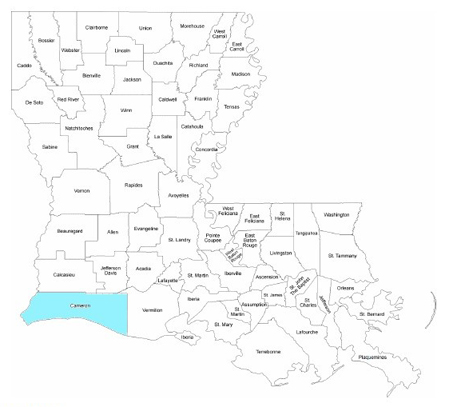


Western Wood Pewee (Contopus richardsonii) (1979-04; formerly 81-8). One unsexable individual collected 20 October 1979 (Steven W. Cardiff, James Van Remsen) at Peveto Beach Woods, Cameron Parish. Specimen (LSUMZ 94258) is third for Louisiana and was assigned by Allan R. Phillips to C. r. saturatus, a race occurring from SE Alaska to NE California.
Western Wood Pewee (Contopus richardsonii) (1979-05; formerly 81-9). One unsexable individual collected 21 October 1979 by David Bruce Crider (with Eleanor Heath, Stanley Heath, Nancy L. Newfield, Paul Newfield) at Holly Beach, Cameron Parish. Specimen (LSUMZ 94337) is fourth for Louisiana, the last three of which were collected in October 1979.
One male (1981-11; formerly 89-33) on 10 Oct. 1981, Cameron: Peveto Beach Woods, J. V. Remsen, Mike Braun, (LSUMZ #100925;AB 36(2): 187).
Western Wood Pewee (Contopus sordidulus). (81-39). Van Remsen collected an immature on 11 October 1981 at Little Cheniere Ridge, Cameron Parish; specimen deposited at the Louisiana State University Museum of Zoology (LSUMZ 100498).
One (1982-30) collected (LSUMZ 105627) at Hackberry Ridge, Cameron Parish on 12 September 1982 (Steven W. Cardiff). This is the sixth accepted record for Louisiana. All accepted records are from fall, and all are of specimens (the species would be almost impossible to identify with certainty in life during fall migration). The present record is 3 1/2 weeks earlier than any other from Louisiana.
One immature male (1986-31; formerly 89-104) on 27 Sep. 1986, Cameron: Willow Island; Steven W. Cardiff, Ronald J. Stein (LSUMZ #131114), Melvin Weber. Erroneously reported as 29 Sep. in AB 41(1):102.
One immature male (2004-51) on 6 Nov 2004, Cameron: Hwy. 82, approximately 4 mi. W of
Garner Ridge;
Phillip A. Wallace
(ph), Paul E. Conover
[ph] (LSUMZ 177864, Steven W. Cardiff*),
found by David P Muth; NAB59(1):92.
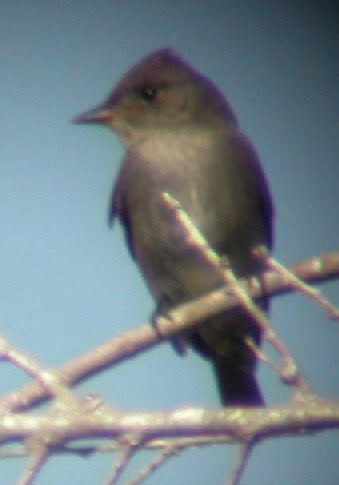
Photo by Paul Conover
One (2010-118) on 8-9 May 2010, Cameron: Johnsons Bayou, Peveto Woods Sanctuary;
Phillip Wallace
(video).
Video by Phillip Wallace
One first-year male (2016-066) on 17 September 2016, Cameron:
Johnsons Bayou; Paul E. Conover (LSUMZ uncat.) and Donna L.
Dittmann (DLD 11008, right top).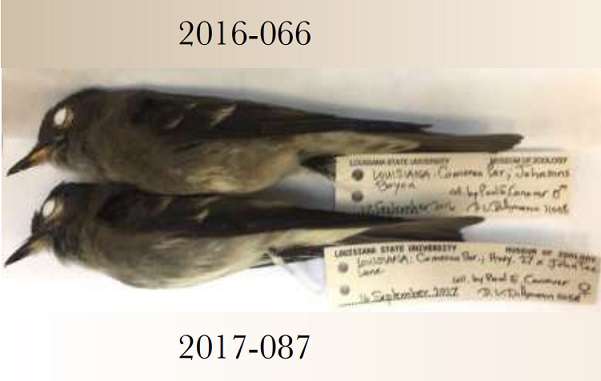
Photo by Donna L. Dittmann
One first-year female (2017-087) on 16 September 2017,
Cameron: Hwy. 27 X John Tee Ln.;
Paul E. Conover (LSUMZ uncat.) and
Donna L. Dittmann (DLD 11058, right bottom). Additional material: Van Remsen (ph, video), copy of eBird checklist
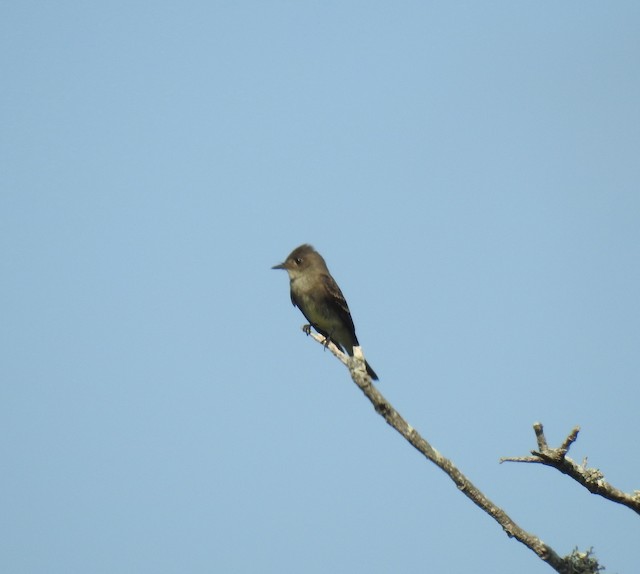
Photo by Van Remsen
One immature male (2019-037) on 21 September 2019, Cameron: vicinity of Cameron; Paul E. Conover (ph,
LSUMZ) and Donna L. Dittmann (DLD 11749, ph).
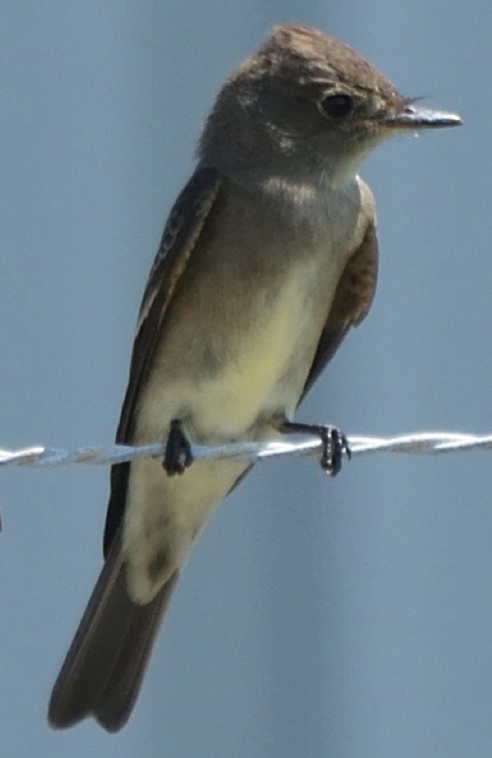
Photo by Paul Conover
One (2022-054) vocalizing on 22 May 2022, Cameron: Peveto Woods Sanctuary: Paul Conover (audio).
One immature male (2022-047) on 30 September 2022, Cameron: Willow Island, 7 mi. W Cameron; Paul E. Conover
(ph, LSUMZ) and D. L. Dittmann (DLD 12039). Embedded sonograms created by Robert C. Dobbs.
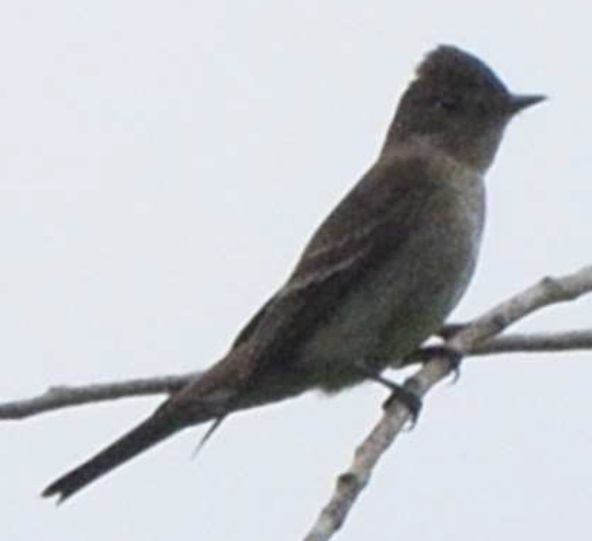
Photo by Paul E. Conover
One hatch-year, sex unknown (2023-110) on 23 September 2023, Cameron: Willow Island; Paul Conover (specimen to LSUMNS).
One (1992-52) on 20 Sep 1992, Jefferson: Grand Isle, N of Hwy. 1 and 1/4 mi. W of Exxon Road. The observers wrote a very detailed report and obtained photographs, but the Committee nonetheless concluded that Eastern Wood-Pewee (Contopus virens) could not be confidently excluded from consideration.
One (1993-35) on 15 Apr 1993, Cameron: Smith Woods, 0.5 mi. N of Johnsons Bayou. Separation of wood-pewees is notoriously difficult, and there are no accepted spring records of Western Wood-Pewee for Louisiana. In this case, the plumage and voice descriptions did not convincingly eliminate the much more likely Eastern Wood-Pewee.
One immature female (2000-061) on 29 October 2000, Cameron: 1.5 mi. E old mouth Mermentau River (LSUMZ 171770). Although a relatively dark individual, and reportedly heard giving sordidulus vocalizations, the specimen is otherwise consistent with, and identified in the collection as, an Eastern Wood-Pewee.
One (2000-37) on 8 Nov 2000, Cameron: Peveto Beach Woods. Although the plumage description was suggestive of this species, and the bird was heard calling, the voice description was ambiguous. The observer also expressed some doubt as to the certainty of the identification. The Committee, therefore opted not to accept this sight record.
Two, possibly three in worn adult plumage (2006-068) on 26 October 2006, Caddo: Shreveport, Stoner Boat Launch on Red River. Following two circulations, all but one Member believed that the details were not sufficient to support identification of this species. Although heard, the call description was inconclusive to some Members.
One (2009-66) on 1 October 2009, Cameron: BRAS Peveto Woods Sanctuary. See also 2009-65 that may pertain to the same individual. Most Members agreed that although the photos may be suggestive of a Western Wood-Pewee, none showed diagnostic characters sufficient for species identification. The overall darkness shown by the bird in the photos may have been an artifact of lighting. That this individual was reported to respond positively (but not vocally) to playback of Western Wood-Pewee does not confirm its identification.
One (2009-65) on 4 October 2009, Cameron: BRAS Peveto Woods Sanctuary. See also 2009-66. Although the photographs were suggestive of this species, the best characters for identification were not visible in the photographs, nor were they described or discussed in the written report. This individual was not heard.
One (2009-81) on 1 November 2009, Cameron: Rockefeller Refuge headquarters. The observer made this identification �after-the-fact� after listening to recordings of pewee vocalizations. It is unclear from the description whether these refer to song or call. Most members believed there was insufficient detail to eliminate Eastern Wood-Pewee.
One (2010-103) on 19, 23-24, and 27 October 2010, Cameron: Johnsons Bayou, Peveto Woods Sanctuary (ph). Multiple reports were combined as one record for the purpose of this review because: 1) fall migrants can remain for several days, and 2) subsequent observers who submitted reports were looking for a reported Western Wood-Pewee. It was unclear whether more than one individual was represented during the date range and the photos were not adequate to determine this. Given the opportunity, Committee Members chose to not review the records separately, although some Members were not convinced the same bird was involved in photos taken on an different days. Whereas some of the photographs suggested this species based on overall darkness of the plumage, most images were underexposed. The photographed individual was silent, and a reportedly calling individual was not photographed. �Dark� Eastern Wood-Pewees are occasionally found and hybrids have also been confirmed. Ultimately, Members believed that neither the photos nor descriptions were adequate to assess critical features like head-back contrast to confirm species identification.
One (2011-119) on 13 September 2011, Cameron: Peveto Woods Sanctuary. Although possibly a Western Wood-Pewee, Members were not able to adequately evaluate the bird�s appearance based on only two photos, neither showing a dorsal view. It is important to note that some Eastern Wood-Pewees can appear relatively dark-plumaged and can possess dark lower mandibles.
One in presumed fresh juvenal plumage (2011-110) on 1 October 2011, Cameron: Lighthouse Rd., S of Hwy. 82. Most Members believed that this record did not include adequate detail or photographic views to definitively identify this individual as a Western Wood-Pewee.
One (2015-055) on 1 November 2015, Cameron: Johnsons Bayou, Peveto Woods Sanctuary; (ph and audio). Excellent documentation was provided by one of several observers. Most Members believed that the sound recordings were more consistent with a hoarse Eastern Wood-Pewee (e.g., same cadence) than a Western. The plumage also supports a typical Eastern Wood-Pewee, e.g., noticeable crown-nape contrast, overall coloration not dark enough for Western, and lacking Western�s more uniform dark brownish wash across the chest. Note also that hybrids are known to occur (Robbins and Manthey 2016), a possible explanation for certain odd-sounding/ appearing individuals.
One (2019-047) on 26 October 2019, Cameron: Johnsons Bayou, Peveto Woods Sanctuary (photos). Description and photos were considered inconclusive.
One (2021-064) on 10-11 September 2021, Cameron: Johnsons Bayou, Peveto Woods Sanctuary (ph). This individual was fairly extensively photographed but not heard. Ultimately all but one Member did not believe that the documentation was adequate to support the identification. Photos did not show the crown, nape, or back, which one Member believed were critical features. Many Members thought the photos were actually suggestive of a Western Wood-Pewee, but considered voice essential to clinch the identification.
All but one of the accepted records of this species have been during the fall migration period, and the majority of accepted records are supported by specimens. Documentation for this species should include a series of photographs and audio. Western Wood-Pewee continues to represent one of the more difficult species to adequately document.